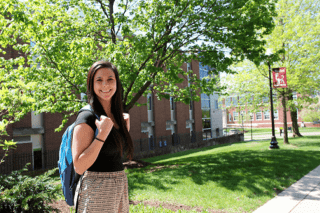Career path in focus for medical imaging major
Bloomsburg
Posted

Sunni Criste is well on her way to achieving a lifelong dream of working in the medical field thanks to Bloomsburg University’s medical imaging program.
“I’ve always loved how things are constantly changing and improving, along with the helping aspect to it,” said Criste, a senior medical imaging major also pursuing a minor in gerontology. “I went to a career and technology school for high school, which allowed me to visit hospitals and out-patient centers to shadow different medical imagers. I knew that’s exactly what I wanted to do.”
This summer she begins her 18-month clinical experience at Johns Hopkins Hospital in Baltimore, which will complete her requirements for a bachelor’s in medical imaging. The next step will be sitting for the national registry exams.
“Bloomsburg’s medical imaging program offers everything I could’ve ever wanted with this major,” Criste said. “It’s been a challenging, yet rewarding program and has made me realize this is exactly what I should be doing.”
Medical imaging technologists are allied health professionals with expertise in operating imaging equipment and preparing patients for various diagnostic and treatment procedures. Specialties may include radiography, nuclear medicine, sonography, radiation therapy, cardiovascular technology, magnetic resonance imaging, computed tomography, positron emission tomography and mammography.
“One of my favorite aspects of BU’s program was having my internship at Susquehanna Valley Imaging,” Criste said. “I wasn’t quite sure whether I wanted to take the radiography path or the sonography path. By the first two weeks of this internship, I knew that radiography was for me.”
During her internship, Criste spent 120 hours shadowing sonographers, mammogram techs, X-ray techs, MRI techs and CT techs.
“My internship taught me things you don’t always learn in the classroom like, learning how to approach situations where the patient was claustrophobic, scared or even younger patients who weren’t aware of what was going on,” Criste said. “I think it’s extremely important to learn how to interact with patients and what to do if something goes wrong, and my internship definitely taught me that.”
According to Criste, BU’s medical imaging program prepared her well for the Johns Hopkins clinical.
“Even though you’re assigned to one advisor, everyone involved in the MI program is more than happy to help you,” Criste said. “The program can be a little confusing at first, so it’s important that you get your questions answered and the professors do a great job of that. Even my professors for the classes I had to take for the program were always more than happy to help me outside of class to make sure I understood the material.”
Criste said applying to clinical was probably the most stressful (yet rewarding) thing she had to do in college.
“Each clinical school has different applications, different paperwork, a certain amount of reference letters, as well as transcripts and such,” Criste said. “This is when the advisors and professors were most helpful and very understanding if you had a million questions like I did. When you start applying to clinical one of the advisors sits you down and has a whole presentation on how the process works.”
According to Criste, she knew early in the process Johns Hopkins was the clinical site for her.
“I visited before I started applying to clinical to see if it would be a good fit for me, and I absolutely loved it,” Criste said. “All of the professors and coordinators — and even the students — were super helpful when I was asking them questions. I could tell all of them had a passion for what they were doing. Each of the current clinical students said they loved being at Hopkins. It was just a wonderful environment to step into. I felt right at home when I visited there, so when I got accepted there I knew that’s where I had to go.”
Much like her internship where she discovered a passion for radiology, Criste says she is looking forward to finding more clarity to her career path.
“After clinical I’m thinking about staying an extra six months to get my certification in MRI, so I will be able to do x-rays and MRIs,” Criste said. “If that isn’t the path I take, then I hope to land a job at Johns Hopkins or somewhere down south and get to start doing what I love to do. I hope I can make a difference in someone’s life and be there for patients when they need me.”



